Bird Surveys
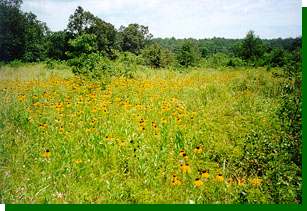 Camp Joseph T. Robinson, located in North Little Rock, Arkansas, is a 33,000-acre (13,313-hectare) training facility of the Army National Guard. Soldiers take part in a wide variety of infantry, artillery, and small weapons training exercises at this base. Despite these activities, much of the habitat for birds and other wildlife is relatively undisturbed.
Camp Joseph T. Robinson, located in North Little Rock, Arkansas, is a 33,000-acre (13,313-hectare) training facility of the Army National Guard. Soldiers take part in a wide variety of infantry, artillery, and small weapons training exercises at this base. Despite these activities, much of the habitat for birds and other wildlife is relatively undisturbed.
No long-term, systematic observations of bird occurrence on Camp Robinson were made until the mid-1990s. From 1994 to 1996, a University of Arkansas graduate student conducted a study of bird habitat usage on Camp Robinson. Along with 137 other species, he observed 4 species that are suffering from population declines throughout large portions of their ranges and that may breed on Camp Robinson: Bachman’s Sparrow, Loggerhead Shrike, Cerulean Warbler, and Northern Bobwhite.
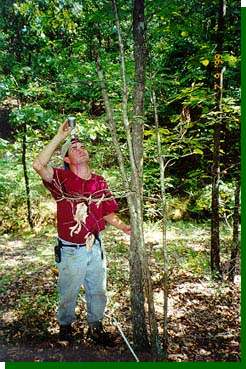 To help protect these species on Camp Robinson, the Army National Guard contracted the Sutton Avian Research Center to identify important areas and habitats for these birds, potential threats to their continued presence on the camp, and actions that would conserve their populations and improve habitat.
To help protect these species on Camp Robinson, the Army National Guard contracted the Sutton Avian Research Center to identify important areas and habitats for these birds, potential threats to their continued presence on the camp, and actions that would conserve their populations and improve habitat.
From 19 April to 30 July 1999, we conducted surveys for these species to determine where they were occurring on Camp Robinson and to estimate their population sizes. We also searched for their nests plus the nests of other species to find out if Brown-headed Cowbirds were negatively affecting their reproductive efforts.
Bachman’s Sparrows
Beginning in late April 1999, we searched Camp Robinson for Bachman’s Sparrows and their habitat. We recorded 44 detections of sparrows. Many of these detections were of the same individuals – there were probably 15 or so singing birds during the study. Some of these birds were present throughout the study. Others were only seen once or twice. We also found 2 nests and 2 groups of fledglings, showing that Camp Robinson is used for breeding by sparrows. Based on the continued presence of singing males at several locations, we estimate that 7-9 pairs attempted to breed in 1999.
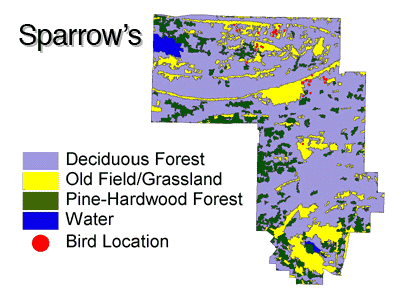
All but one sparrow was found in old fields with a grassy understory and a few scattered trees. The exception was found singing in a small opening in a planting of pines. We measured several characteristics of the vegetation at spots where sparrows were found and made comparisons to vegetation at random spots in open fields. For the most part, the vegetation was similar, but there were fewer shrubs in sparrow habitat.
Northern Bobwhites
As we did for the other species of concern, we searched for Northern Bobwhites and their habitat beginning in late April. We recorded 149 detections. As with sparrows, many individuals were detected multiple times.
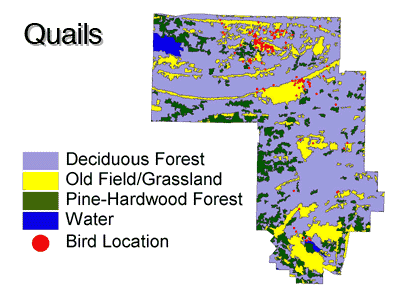
We found bobwhites in a variety of habitats, but they were most common in and near old fields. We measured vegetation characteristics at locations where we found bobwhites and then made comparisons to vegetation at random spots in old fields. At bobwhite locations, there were greater amounts of canopy cover and shrubs and less ground cover and ground vegetation density.
Brown-headed Cowbirds and Nest Parasitism
We recorded the locations of Brown-headed Cowbirds beginning in late April. We recorded 145 locations. Unlike the other species we studied, cowbirds were widespread on Camp Robinson and were found in almost all areas and habitats we visited. However, they appeared to be most numerous in old fields.
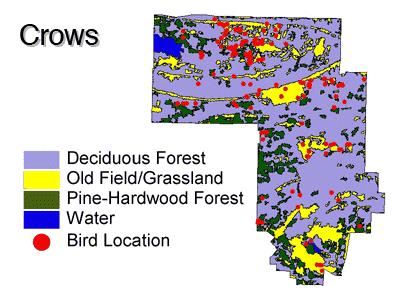
We found and monitored 46 nests of potential cowbird host species. Most of the nests were located in old fields. We found 6 nests (13 percent) that were parasitized by cowbirds, but of those 6 nests, the host bird accepted the egg in only 2 cases. Host birds usually abandoned the nest when a cowbird laid an egg in it.
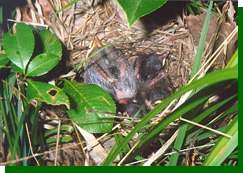
Three host eggs and one cowbird egg ultimately hatched, but the nest was later destroyed by a mammalian predator
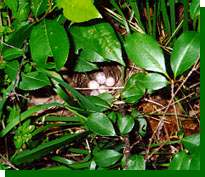
The top and bottom eggs in this Kentucky Warbler nest were laid by cowbirds
Of course, cowbirds may have parasitized nests more frequently; however, finding a nest after it has been abandoned is very difficult. Also, we would not know if a nest was parasitized if the host ejected the cowbird’s egg.
Compared to cowbird parasitism, nest predation was a much more frequent cause of nest failure. Nineteen of the 46 nests were depredated, and an equal number successfully fledged young. In many cases of predation, the nest structure was not disturbed, suggesting that the major nest predators were snakes – mammals such as raccoons tend to pull the nest down.

Loggerhead Shrikes and Cerulean Warblers
During our searches for Loggerhead Shrikes and Cerulean Warblers, we located only 2 shrikes and 1 warbler, and all birds were seen only once in April and May. The individuals we found were probably still migrating. These species are probably not breeding on Camp Robinson.
Conclusions
Suitable habitat exists on Camp Robinson for Bachman’s Sparrows and Northern Bobwhites. Management actions such as prescribed burning will help maintain habitat and perhaps create new areas for breeding by these species.
Loggerhead Shrikes and Cerulean Warblers do not breed on Camp Robinson. For shrikes, the reasons why are not clear. Their absence may be due to a lack of the appropriate trees and shrubs in which to build their nests. The creation of hedgerows in open areas with short grass, such as the golf course, may provide nesting habitat. Forest species composition, structure, and age on Camp Robinson is not suitable for Cerulean Warblers.
Brown-headed Cowbird nest parasitism rates are relatively low, and host species apparently have developed a strategy (nest abandonment) to deal with parasitism. Cowbirds do not need to be controlled on Camp Robinson as they appear to have no significant impact on breeding of host species.
Species Observed
Birds, reptiles, mammals, and butterflies detected on Camp Robinson, 19 April – 30 July 1999.
Total bird species: 132 Total reptile species: 18
| Species | Scientific Name |
|---|---|
| BIRDS | |
| American White Pelican | Pelecanus erythrorhynchos |
| Great Blue Heron | Ardea herodias |
| Snowy Egret | Egretta thula |
| Little Blue Heron | Egretta caerulea |
| Green Heron | Butorides virescens |
| Yellow-crowned Night-Heron | Nyctanassa violacea |
| Turkey Vulture | Cathartes aura |
| Wood Duck | Aix sponsa |
| Mississippi Kite | Ictinia mississippiensis |
| Northern Harrier | Circus cyaneus |
| Cooper's Hawk | Accipiter cooperii |
| Red-shouldered Hawk | Buteo lineatus |
| Broad-winged Hawk | Buteo platypterus |
| Red-tailed Hawk | Buteo jamaicensis |
| American Kestrel | Falco sparverius |
| Wild Turkey | Meleagris gallopavo |
| Northern Bobwhite | Colinus virginianus |
| Killdeer | Charadrius vociferus |
| Solitary Sandpiper | Tringa solitaria |
| Spotted Sandpiper | Actitis macularia |
| Mourning Dove | Zenaida macroura |
| Black-billed Cuckoo | Coccyzus erythropthalmus |
| Yellow-billed Cuckoo | Coccyzus americanus |
| Greater Roadrunner | Geococcyx californianus |
| Eastern Screech-Owl | Otus asio |
| Barred Owl | Strix varia |
| Common Nighthawk | Chordeiles minor |
| Chuck-will's-widow | Caprimulgus carolinensis |
| Whip-poor-will | Caprimulgus vociferus |
| Chimney Swift | Chaetura pelagica |
| Ruby-throated Hummingbird | Archilochus colubris |
| Red-headed Woodpecker | Melanerpes erythrocephalus |
| Red-bellied Woodpecker | Melanerpes carolinus |
| Downy Woodpecker | Picoides pubescens |
| Hairy Woodpecker | Picoides villosus |
| Northern Flicker | Colaptes auratus |
| Pileated Woodpecker | Dryocopus pileatus |
| Olive-sided Flycatcher | Contopus cooperi |
| Eastern Wood-Pewee | Contopus virens |
| Acadian Flycatcher | Empidonax virescens |
| Alder Flycatcher | Empidonax alnorum |
| Least Flycatcher | Empidonax minimus |
| Eastern Phoebe | Sayornis phoebe |
| Great-crested Flycatcher | Myiarchus crinitus |
| Eastern Kingbird | Tyrannus tyrannus |
| Scissor-tailed Flycatcher | Tyrannus forficatus |
| Loggerhead Shrike | Lanius ludovicianus |
| White-eyed Vireo | Vireo griseus |
| Bell's Vireo | Vireo bellii |
| Yellow-throated Vireo | Vireo flavifrons |
| Blue-headed Vireo | Vireo solitarius |
| Philadelphia Vireo | Vireo philadelphicus |
| Red-eyed Vireo | Vireo olivaceus |
| Blue Jay | Cyanocitta cristata |
| American Crow | Corvus brachyrhynchos |
| Fish Crow | Corvus ossifragus |
| Purple Martin | Progne subis |
| Northern Rough-winged Swallow | Stelgidopteryx serripennis |
| Barn Swallow | Hirundo rustica |
| Carolina Chickadee | Poecile carolinensis |
| Tufted Titmouse | Baeolophus bicolor |
| White-breasted Nuthatch | Sitta carolinensis |
| Carolina Wren | Thryothorus ludovicianus |
| House Wren | Troglodytes aedon |
| Sedge Wren | Cistothorus platensis |
| Ruby-crowned Kinglet | Regulus calendula |
| Blue-gray Gnatcatcher | Polioptila caerulea |
| Eastern Bluebird | Sialia sialis |
| Gray-cheeked Thrush | Catharus minimus |
| Swainson's Thrush | Catharus ustulatus |
| Hermit Thrush | Catharus guttatus |
| Wood Thrush | Hylocichla mustelina |
| American Robin | Turdus migratorius |
| Gray Catbird | Dumetella carolinensis |
| Northern Mockingbird | Mimus polyglottos |
| Brown Thrasher | Toxostoma rufum |
| European Starling | Sturnus vulgaris |
| Cedar Waxwing | Bombycilla cedrorum |
| Blue-winged Warbler | Vermivora pinus |
| Golden-winged Warbler | Vermivora chrysoptera |
| Tennessee Warbler | Vermivora peregrina |
| Orange-crowned Warbler | Vermivora celeta |
| Nashville Warbler | Vermivora ruficapilla |
| Northern Parula | Parula americana |
| Yellow Warbler | Dendroica petechia |
| Chestnut-sided Warbler | Dendroica pensylvanica |
| Magnolia Warbler | Dendroica magnolia |
| Yellow-rumped Warbler | Dendroica coronata |
| Black-throated Green Warbler | Dendroica virens |
| Blackburnian Warbler | Dendroica fusca |
| Pine Warbler | Dendroica pinus |
| Prairie Warbler | Dendroica discolor |
| Palm Warbler | Dendroica palmarum |
| Bay-breasted Warbler | Dendroica castanea |
| Cerulean Warbler | Dendroica cerulea |
| Black-and-white Warbler | Mniotilta varia |
| American Redstart | Setophaga ruticilla |
| Prothonotary Warbler | Protonotaria citrea |
| Worm-eating Warbler | Helmitheros vermivorus |
| Ovenbird | Seiurus aurocapillus |
| Northern Waterthrush | Seiurus noveboracensis |
| Louisiana Waterthrush | Seiurus motacilla |
| Kentucky Warbler | Oporornis formosus |
| Mourning Warbler | Oporornis philadelphia |
| Common Yellowthroat | Geothlypis trichas |
| Hooded Warbler | Wilsonia citrina |
| Wilson's Warbler | Wilsonia pusilla |
| Canada Warbler | Wilsonia canadensis |
| Yellow-breasted Chat | Icteria virens |
| Summer Tanager | Piranga rubra |
| Eastern Towhee | Pipilo erythrophthalmus |
| Bachman's Sparrow | Aimophila aestivalis |
| Chipping Sparrow | Spizella passerina |
| Field Sparrow | Spizella pusilla |
| Lark Sparrow | Chondestes grammacus |
| Lincoln's Sparrow | Melospiza lincolnii |
| Swamp Sparrow | Melospiza georgiana |
| White-throated Sparrow | Zonotrichia albicollis |
| Northern Cardinal | Cardinalis cardinalis |
| Rose-breasted Grosbeak | Pheucticus ludovicianus |
| Blue Grosbeak | Guiraca caerulea |
| Indigo Bunting | Passerina cyanea |
| Dickcissel | Spiza americana |
| Red-winged Blackbird | Agelaius phoeniceus |
| Eastern Meadowlark | Sturnella magna |
| Common Grackle | Quiscalus quiscula |
| Brown-headed Cowbird | Molothrus ater |
| Orchard Oriole | Icterus spurius |
| Baltimore Oriole | Icterus galbula |
| House Finch | Carpodacus mexicanus |
| American Goldfinch | Carduelis tristis |
| House Sparrow | Passer domesticus |
| REPTILES | |
| Three-toed Box Turtle | Terrapene carolina triunguis |
| Red-eared Slider | Trachemys scripta elegans |
| Softshell Turtle | Apalone sp. |
| Western Slender Glass Lizard | Ophisaurus attenuatus attenuatus |
| Northern Fence Lizard | Sceloporus undulatus hyacinthinus |
| Six-lined Racerunner | Cnemidophorus sexlineatus sexlineatus |
| Broadhead Skink | Eumeces laticeps |
| Southern Coal Skink | Eumeces anthracinus pluvialis |
| Broad-banded Water Snake | Nerodia fasciata confluens |
| Yellowbelly Water Snake | Nerodia erythrogaster flavigaster |
| Garter Snake | Thamnophis sp. |
| Rough Green Snake | Opheodrys aestivus |
| Southern Black Racer | Coluber constrictor priapus |
| Eastern Coachwhip | Masticophis flagellum flagellum |
| Black Rat Snake | Elaphe obsoleta obsoleta |
| Speckled Kingsnake | Lampropeltis getula holbrooki |
| Southern Copperhead | Agkistrodon contortrix contortrix |
| Western Cottonmouth | Agkistrodon piscivorus leucostoma |
| MAMMALS | |
| Nine-banded Armadillo | Dasypus novemcinctus |
| Eastern Cottontail | Sylvilagus floridanus |
| Fox Squirrel | Sciurus niger |
| Beaver | Castor canadensis |
| Coyote | Canus latrans |
| Red Fox | Vulpes vulpes |
| Gray Fox | Urocyon cinereoargenteus |
| Raccoon | Procyon lotor |
| Striped Skunk | Mephitis mephitis |
| White-tailed Deer | Odocoileus virginianus |
| Total mammal species: 10 | |
| BUTTERFLIES | |
| Pipevine Swallowtail | Battus philenor |
| Black Swallowtail | Papilio polyxenes |
| Eastern Tiger Swallowtail | Papilio glaucus |
| Spicebush Swallowtail | Papilio troilus |
| Clouded Sulphur | Colias philodice |
| Cloudless Sulphur | Phoebis sennae |
| Little Yellow | Eurema lisa |
| Banded Hairstreak | Satyrium calanus |
| Red-banded Hairstreak | Calycopis cecrops |
| Eastern Tailed-Blue | Everes comyntas |
| American Snout | Libytheana carinenta |
| Variegated Fritillary | Euptoieta claudia |
| Diana | Speyeria diana |
| Pearl Crescent | Phyciodes tharos |
| Question Mark | Polygonia interrogationis |
| Mourning Cloak | Nymphalis antiopa |
| American Lady | Vanessa virginiensis |
| Red Admiral | Vanessa atalanta |
| Common Buckeye | Junonia coenia |
| Red-spotted Purple | Limenitis arthemis |
| Viceroy | Limenitis archippus |
| Goatweed Leafwing | Anaea andria |
| Hackberry Emperor | Asterocampa celtis |
| Pearly Eye | Enodia sp. |
| Gemmed Satyr | Cyllopsis gemma |
| Little Wood Satyr | Megisto cymela |
| Common Wood Nymph | Cercyonis pegala |
| Hoary Edge | Achalarus cyciades |
| Southern Cloudywing | Thorybes bathyllus |
| Duskywing | Erynnis sp. |
| Common Checkered-Skipper | Pyrgus communis |
| Total butterfly species: 31 |
